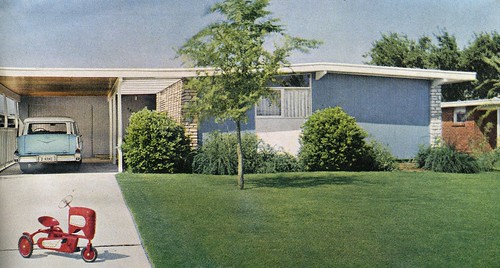Tulsa History: February 2007 Archives
There's an interesting thread over at the TulsaNow Forum about the history Lortondale neighborhood, on the east side of Yale Avenue at 26th Street. The subdivision of homes with low pitched roofs and glass walls was built in 1954 on what had been a farm belonging to the publisher of the Tulsa Whirled (thus the name) and later the original site of Meadowbrook Country Club (now on 81st Street between Memorial and Mingo).
One of the fascinating facts supplied by Steve, a 20-year resident of the subdivision:
Lortondale was the very first merchant builder (speculative) housing development in the United States where all homes were built with central air conditioning as a standard feature, built on slab foundations with in-slab forced air HVAC ducts. Builder Howard Grubb and the Chrysler Air-Temp Corporation featured Lortondale homes in their national magazine ads at the time, and Lortondale made national homebuilding news for this "luxury" feature. An historic homebuilding fact, right here in Tulsa.
He also mentions that Grubb built two model homes in Mayo Meadow neighborhood, just east of Pittsburg on 21st Place.
Lortondale's MySpace page has a scan of the original owner's manual for the homes, plus many contemporary photos and magazine articles about the development's modern features. The neighborhood also has a very well-designed website (although it doesn't seem to be working at the moment).
I'm pretty sure The Incredibles live in Lortondale, or someplace very much like it. Here's a 1956 view of a Lortondale home. (Flickr photo uploaded by Hoodlam.)
And here's a still from The Incredibles (image found here):

I found a very heartwarming thread over on TulsaNow's public forum. Someone calling himself "Hometown" has posted memories and photos from the neighborhood southeast of downtown which was displaced by the construction of the southeastern interchange of the Inner Dispersal Loop. The neighborhood linked together the south edge of downtown -- home to car dealerships and churches -- with the 15th Street (Cherry Street) commercial district, the Tracy Park, Gunboat Park, Maple Ridge North, and South Boston neighborhoods. And the heart of the neighborhood was a grove of locust trees that became a city park, Locust Grove Park.
Hometown's description includes details of the park that he gathered from old maps and newspaper stories and his own memories of living nearby.
Some of my very first memories are of Locust Grove Park. In 1959 we lived on 14th between Cincinnati and Detroit. I was six years old. I can remember sitting in our small front yard at dusk and watching a group of square dancers under the lights of the basketball court. The women wore layers of petticoats causing their colorful skirts to puff out and swirl around. A man with a fiddle called out the dance moves.It’s hard now to imagine that children played in the park and around the neighborhood with little or no supervision. We would take off and walk blocks into downtown or over to the Gunboat neighborhood or further to Tracy Park. But we spent most of our time in Locust Grove Park.
He has a picture of himself in front of the park's recreation center in 1959, in front of his house on 14th Street between Cincinnati and Detroit in 1960, and the next house he lived in, on Norfolk Ave. in Tracy Park, in 1960 -- the houses in the background of the photo were demolished for the construction of the east leg of the IDL (I-444 / US 75).
Other people who remember that place and time are chiming in with memories of their own. Hometown promises more photos and more memories in the future.
This is exactly the sort of recording and sharing of memories that I had hoped would emerge in this centennial year. (It was the topic of my column in this week's UTW.)
Hometown's tagline on the TulsaNow forum is "Tulsa's best days are ahead of us." If that's to be true, we need to remember the good days that once were. We need to remember what Tulsa was like before our leaders began to shred it to pieces, so that we can, to whatever extent possible, repair the damage that was done.
